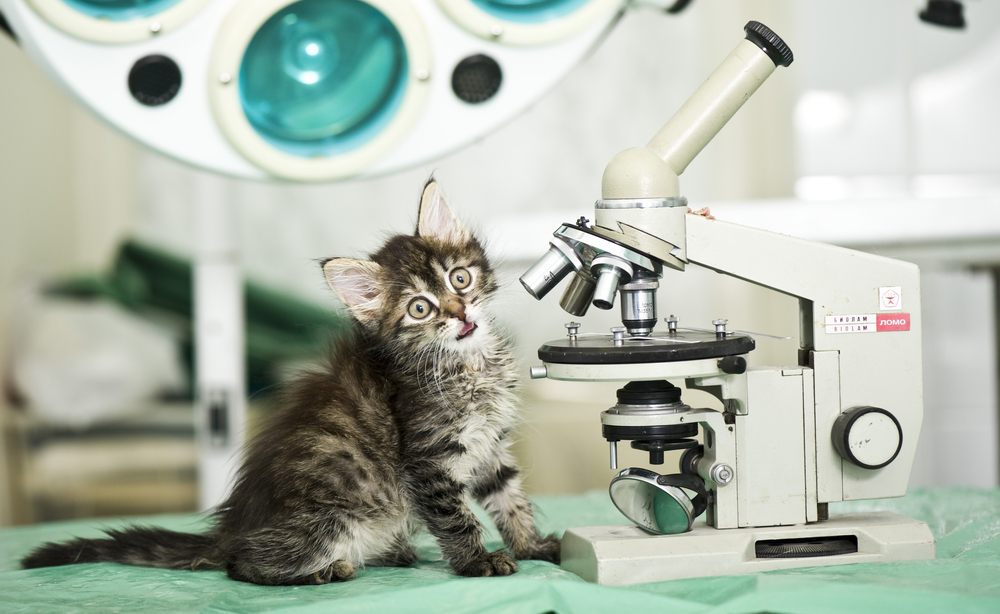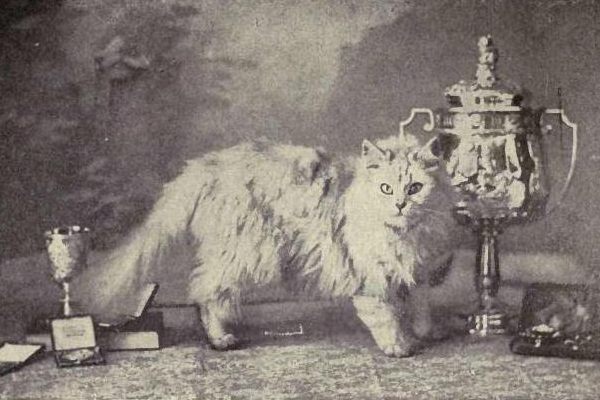In 1975, a Cat Co-Authored a Physics Paper
Meet F.D.C. Willard, the feline who published.

THIS IS A DRAMATIZATION. (Photo: Kachalkina Veronika/Shutterstock.com)
When one reads a physics paper in an esteemed journal, one does not generally wonder if it was written by a cat. But such was the case for an article in the 1970s credited to co-author F.D.C. Willard—the Cat Who Published.
Jack H. Hetherington was a professor of physics at Michigan State University in 1975, when he finished what would become an influential and often-cited physics paper. The academic writing, entitled Two-, Three-, and Four-Atom Exchange Effects in bcc 3He, was an in-depth exploration of atomic behavior at different temperatures. It would have flown over the heads of most lay people, not to mention cats.
He was all set to send it to Physical Review Letters, which today describes itself as “the world’s premier physics letter journal.” However, before he dispatched it, Hetherington gave the paper to a colleague to get one last set of eyes on the piece. This is when he ran into a strange problem. Hetherington had used the royal “we” throughout the paper. As his colleague pointed out, Physical Review Letters generally only published papers using plural pronouns and adjectives like “we” and “our” if the paper had multiple authors.
Now I Know points out that in 1975 Hetherington couldn’t have simply done a find-and-replace to correct the offending articles. In fact the whole paper had been produced on a typewriter.
In the 1982 book More Random Walks in Science, Hetherington gave other reasons for not wanting to add another human authors, including the fact that the compensation for a published piece is changed with each additional author, that a scientific writer’s reputation is tied up in what they publish, and that prestige can take a hit when multiple authors are involved.

F.D.C. Willard was a Siamese cat just like this one. (Photo: rehaji/Public Domain)
Hetherington wrote that after giving the issue “an evening’s thought,” he decided the paper was so good that it required rapid publishing. Unwilling to go back and replace the plural voice in the document, he did the next best thing and just added a second author: his Siamese cat, Chester. Of course just listing “Chester” as a co-author probably wouldn’t fly, so he invented the name F.D.C. Willard. The “F.D.C.” stood for “Felix Domesticus, Chester.” Willard had been the name of Chester’s father.
Portraying F.D.C. Willard as one of his colleagues at Michigan State, Hetherington submitted his paper, and it was published in issue 35 of Physical Review Letters.
Hetherington didn’t feel too bad about the deception, recognizing the possible publicity value of such a stunt. In More Random Walks in Science, he wrote: “Why would I do such an irreverent thing? … If it eventually proved to be correct, people would remember the paper more if the anomalous authorship were known. In any case I went ahead and did it and have generally not been sorry.”
After the paper was published, it didn’t take long for Willard’s true identity to come to light. The first time anyone outside of Hetherington’s close colleagues learned of the cat scientist was when a visitor to the college came looking for the authors. Hetherington was away. As quoted in a piece on Today I Found Out, Hetherington said, “Everyone laughed and soon the cat was out of the bag.”

The signed version of the paper. (Photo: More Random Walks in Science/Google Books)
After that casual reveal, Hetherington leaned into the joke and even issued a handful of article reprints signed by both authors. His was a standard signature, while Willard’s was a pawprint. Clearly, Hetherington wasn’t too worried about how the community would take to his kitty co-author. He even began describing Chester/Willard as the university’s “Rodentia Predation Consultant.”
University officials seemed to love the idea of the cat as a sort of physics mascot. In 1975, the college’s Physics Chairman, Truman Woodruff, even wrote a letter to Hetherington, asking him if he could persuade Willard to join the department full time. The letter read, in part, “Can you imagine the universal jubilation if in fact Willard could be persuaded to join us, even if only as a Visiting Distinguished Professor?”
According to Hetherington, the only people who didn’t think the joke was very funny were editors.
Willard went on to publish another paper in 1980, this time being credited as the sole author (assumedly Hetherington helped out a little, too). This paper, written completely in French, was published in the popular science magazine, La Recherche. While it didn’t hold the prestige or exciting surprise as his first published piece, who knew the cat spoke French?
Willard’s short but sweet publishing career did have a lasting effect on cat-authored physics papers. Inspired by the kitty’s contributions to physics, the American Physical Society declared in 2014 that all cat-authored papers would now be available as open-access documents. The date of this declaration? April 1.
















Follow us on Twitter to get the latest on the world's hidden wonders.
Like us on Facebook to get the latest on the world's hidden wonders.
Follow us on Twitter Like us on Facebook